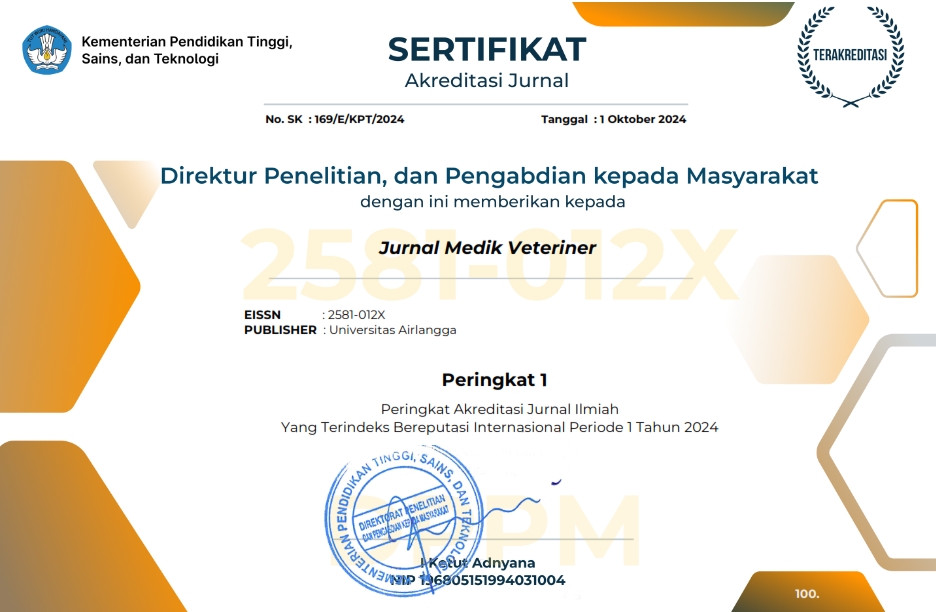Prevalence of Ectoparasites in Tilapia (Oreochromis niloticus) in Sidoarjo, Indonesia

The problem most often encountered in fish farming is disease which can cause a decrease in fish production levels. Parasites cause one of the infectious diseases found in fish farming. The presence of parasites can cause a decrease in the quality of the growth of fish production. The purpose of this study was to identify the prevalence of ectoparasites on Nile tilapia in Sidoarjo, Indonesia. Ninety-six samples from two ponds were examined under the microscope to find out the presence of ectoparasite that exists in the outside body part of the fish. Samples were collected from skin, fins, tail, and gills using native methods and observed under a microscope in the Division of Parasitology Laboratory, Faculty of Veterinary Medicine, Universitas Airlangga. The results of this study showed 86 samples positively infected by ectoparasite and 10 showed negative. The ectoparasites found in this study were Trichodina sp., Chilodonella sp., Ichthyophthirius multifillis, Gyrodactylus sp., and Dactylogyrus sp. The highest prevalence is Trichodina sp. and Dactylogyrus sp. The number of fish infested by ectoparasite is 89.56%, this is classified in the usual category. The highest prevalence occurs in infestations of Trichodina sp. i.e.72.91% which were contained in the 70 samples. While the lowest prevalence was in Gyrodactylus sp. by 8.32% in 8 fish samples. Double infections from two different ponds were 70% within 33 samples which were included in the usual category.
Anshary, H., Sriwulan, S., & Amriana, A. (2023). High prevalence and mean intensity of trichodinids and monogeneans on Nile tilapia (Oreochromis niloticus) in Indonesian hatcheries. Veterinary Parasitology: Regional Studies and Reports, 43(1), 100898.
Arumugam, K., Budiono, N. G., & Widyananta, B. J. (2024). Isolation and Identification of Aspergillus sp. in Tilapia (Oreochromis sp.) Sold for Consumption in Bogor. Jurnal Medik Veteriner, 7(1), 187–204.
Bakri, M., Asy’ari, I. M., Eliawardani, Hambal, M., Winaruddin, Darmawi, Azhari, & Novita, A. (2020). Identification of Parasites on the Shark Fish (Selachimorpha) in Peunayong Fish Market Banda Aceh City. Jurnal Medika Veterinaria, 14(2), 147–150.
Binning, S. A., Roche, D. G., & Layton, C. (2013). Ectoparasites increase swimming costs in a coral reef fish. Biology Letters, 9(1), 20120927.
Coppola, D., Lauritano, C., Esposito, F. P., Riccio, G., Rizzo, C., & de Pascale, D. (2021). Fish Waste: From Problem to Valuable Resource. Marine Drugs, 19(2), 116.
Dargent, F., Torres-Dowdall, J., Scott, M. E., Ramnarine, I., & Fussmann, G. F. (2013). Can mixed-species groups reduce individual parasite load? A field test with two closely related poeciliid fishes (Poecilia reticulata and Poecilia picta). PLoS One, 8(2), e56789.
Davidovich, N., Yasur-Landau, D., Behar, A., Pretto, T., & Scholz, T. (2023). Invasive parasites and global change: Evidence for the recent and rapid spillover of a potential pathogen of tilapias with a complex, three-host life cycle. Heliyon, 9(9), e18831.
Deák, G., Holban, E., Sadîca, I., & Jawdhari, A. (2024). Sturgeon Parasites: A Review of Their Diversity and Distribution. Diversity, 16(3), 163.
Fikri, F., Wardhana, D. K., Purnomo, A., Khairani, S., Chhetri, S., & Purnama, M. T. E. (2022). Aerolysin gene characterization and antimicrobial resistance profile of Aeromonas hydrophila isolated from milkfish (Chanos chanos) in Gresik, Indonesia. Veterinary World, 15(7), 1759.
Fuadi, A. A., Hasly, I. R. J., Azkia, L. I., & Irham, M. (2021). Response of tilapia (Oreochromis niloticus) behaviour to salinity differences: a laboratory scale study. IOP Conference Series: Earth and Environmental Science, 674(1), 012060.
Grano-Maldonado, M. I. (2018). Ultrastructure Study of the Stored Lipid Reserves in Gyrodactylus gasterostei (Monogenea) Using Confocal and Transmission Electron Microscopy. Journal of Microscopy and Ultrastructure, 6(2), 65–71.
Huang, K., Hu, G., Wang, R., Zeng, Q., Li, W., Zou, H., Wu, S., Wang, G., & Li, M. (2022). In Vitro Assessment of Berberine against Ichthyophthirius multifiliis in Goldfish. Pathogens, 11(10), 1207.
Huyse, T., & Volckaert, F. A. (2002). Identification of a host-associated species complex using molecular and morphometric analyses, with the description of Gyrodactylus rugiensoides n. sp. (Gyrodactylidae, Monogenea). International Journal for Parasitology, 32(7), 907–919.
Ihsan, B., & Sitinjak, R. S. (2023). Prevalence of Ectoparasites in Tilapia (Oreochromis niloticus) in Tarakan. Jurnal Medik Veteriner, 6(2), 185–190.
Iriansyah, A. H., Budiharjo, A., & Sugiyarto. (2020). Parasites prevalence infecting freshwater fishes in Mulur Reservoir of Sukoharjo District, Indonesia. Bonorowo Wetlands, 10(2), 92–97.
Kolia, W. S. K., Sunarto, & Widiyani, T. (2021). The infection of ectoparasitic protozoa on farmed Nile tilapia (Oreochromis niloticus) at three reservoirs in Central Java, Indonesia. Biodiversitas, 22(4), 1975–1980.
López-Pérez, A. M., Pesapane, R., Clifford, D. L., Backus, L., Foley, P., Voll, A., Silva, R. B., & Foley, J. (2022). Host species and environment drivers of ectoparasite community of rodents in a Mojave Desert wetlands. PLoS One, 17(6), e0269160.
Mahasri, G., Aris, D. H., & Kusdarwati, R. (2012). Derajat Infestasi dan Intensitas Ichthyophthirius multifiliis pada Ikan Koi (Cyprinus carpio) dengan Metode Kohabitasi. Jurnal Ilmiah Perikanan dan Kelautan, 4(1), 15–20.
Manurung, U. N. & Gaghenggang, F. (2016). Identification and prevalence of ectoparasite on nile tilapia (Oreochromis niloticus) cultured in Kampung Hiung, Manganitu District, Sangihe Island Regency. Budidaya Perairan, 4(2), 26–30.
Martins, M. L., Cardoso, L., Marchiori, N., & Benites de Pádua, S. (2015). Protozoan infections in farmed fish from Brazil: diagnosis and pathogenesis. Revista Brasileira de Parasitologia Veterinária, 24(1), 1–20.
Mehar, M., Mekkawy, W., McDougall, C., & Benzie, J. A. H. (2023). Tilapia (Oreochromis niloticus) trait preferences by women and men farmers in Jessore and Mymensingh districts of Bangladesh. Aquaculture, 562(1), 738799.
Minggawati, I., Agustinus, F., Augusta, T. S., Pahawang, C. P., & Francisco, T. (2022). Identification and prevalence of ectoparasites and endoparasites in kerandang fish Channa pleurophtalma and catfish Clarias batrachus captured from Sebangau River. Indonesian Journal of Aquaculture, 21(2), 152–160.
Mutyaba, J. L., Ngigi, M. W., & Ayuya, O. I. (2024). Determinants of knowledge, attitude and perception towards cage fish farming technologies among smallholder farmers in Uganda. Cogent Food & Agriculture, 10(1), 1.
Nimah, A., Ardhya, G. S., Plumeriastuti, H., Koesdarto, S., & Budiarto. (2022). Identification of Ectoparasites in Pearl Catfish (Clarias gariepinus) with One and Three Months Age in Maclele Cultivation, Tuban District, Tuban Regency. Journal of Parasite Science, 6(2), 60–66.
Nur, I., Yusnaini, Idris, M., & Sari, A. I. (2020). Study on the impact of environmental pollution: Parasitic infestation andconditionsfactorof fish livingin amalgamation ponds. IOP Conference Series: Earth and Environmental Science, 465(1), 012042.
Omeji, S., Solomon, S. G., & Idoga, E. S. (2011). A Comparative Study of the Common Protozoan Parasites of Clarias gariepinus from the Wild and Cultured Environments in Benue State, Nigeria. Journal of Parasitology Research, 2011(1), 916489.
Osman, K. M., Al-Maary, K. S., Mubarak, A. S., Dawoud, T. M., Moussa, I. M. I., Ibrahim, M. D. S., Hessain, A. M., Orabi, A., & Fawzy, N. M. (2017). Characterization and susceptibility of streptococci and enterococci isolated from Nile tilapia (Oreochromis niloticus) showing septicaemia in aquaculture and wild sites in Egypt. BMC Veterinary Research, 13(1), 357.
Pratama, B. B., Hasibuan, H. S., & Supriatna. (2019). Social adaptation and resilience on disaster, the case of Sidoarjo mudflow. IOP Conference Series: Earth and Environmental Science, 243(1), 012010.
Rahayu, F. D., Ekastuti, D. R., & Tiuria, R. (2013). Infestation of Parasitic Worm at Mujair’s Gills (Oreochromis mossambicus). Acta Veterinaria Indonesiana, 1(1), 8–14.
Rahman, Sukenda, Nuryati, S., & Hidayatullah, D. (2016). The infectivity of Ichtyophthirius multifiliis against low temperature storage. Indonesian Journal of Aquaculture, 5(2), 93–98.
Rani, C. A. M., Safira, A., Suryadiningrat, M., Fikri, F., Wardhana, D. K., & Purnama, M. T. E. (2022). Characterization of Tilapia collagen-loaded chitosan nanofibers synthesized by electrospinning method for wound dressing. IOP Conference Series: Earth and Environmental Science, 1036(1), 012034.
Rokhmani, Darsono, & Riwidiharso, E. (2020). Diversity of Trichodina spp. on The Larvae of Freshwater Fish in Banyumas and Surrounding Areas of Central Java. IOP Conference Series: Earth and Environmental Science, 593(1), 012039.
Romano, M. C., Jiménez, P., Miranda-Brito, C., & Valdez, R. A. (2015). Parasites and steroid hormones: corticosteroid and sex steroid synthesis, their role in the parasite physiology and development. Frontiers in Neuroscience, 9(1), 224.
Safira, A., Rani, C. A. M., Puspitasari, R. A., Ayuningtyas, A. K. P., Mahendra, Y. A., Purnomo, A., Fikri, F., Chhetri, S., & Purnama, M. T. E. (2022). Amino Acid and Proximate Analysis of Type-1 Collagen from Sea Cucumber and Tilapia-Skin and its Potential Application as Artificial Tendon. Pharmacognosy Journal, 14(4), 358–361.
Schelkle, B., Shinn, A. P., Peeler, E., & Cable, J. (2009). Treatment of Gyrodactylid Infections in Fish. Diseases of Aquatic Organisms, 86(1), 65–75.
Shafiq, A., Abbas, F., Hafeez-Ur-Rehman, M., Khan, B. N., Aihetasham, A., Amin, I., Hmidullah, Mothana, R. A., Alharbi, M. S., Khan, I., Khalil, A. A. K., Ahmad, B., Mubeen, N., & Akram, M. (2023). Parasite Diversity in a Freshwater Ecosystem. Microorganisms, 11(8), 1940.
Shamsi, S. (2019). Seafood-Borne Parasitic Diseases: A “One-Health” Approach Is Needed. Fishes, 4(1), 9.
Singh, B. B., Ward, M. P., Kostoulas, P., & Dhand, N. K. (2023). Zoonosis-Why we should reconsider "What's in a name?". Frontiers in Public Health, 11(1), 1133330.
Sunarto, D. (2019). Ectoparasites Identification of Indigo Red Fish (Oreochromis nilotica) Cultivated in The Center of The Fish Fry (BBI) Ranomeeto. Journal of Biological Science & Education, 1(1), 1–8.
Valladão, G. M. R., Alves, L. O., & Pilarski, F. (2016). Trichodiniasis in Nile tilapia hatcheries: Diagnosis, parasite:host-stage relationship and treatment. Aquaculture, 451(1), 444–450.
Zelmer, D. A., Williams, E. H., & Williams, L. B. (1998). Parasites of Offshore Big Game Fishes of Puerto Rico and the Western Atlantic. Journal of Parasitology, 84(2), 283.
Ziarati, M., Zorriehzahra, M. J., Hassantabar, F., Mehrabi, Z., Dhawan, M., Sharun, K., Emran, T. B., Dhama, K., Chaicumpa, W., & Shamsi, S. (2022). Zoonotic diseases of fish and their prevention and control. Veterinary Quarterly, 42(1), 95–118.
Copyright (c) 2024 Aulia Puspita Sari, Setiawan Koesdarto, Tita Damayanti Lestari, Poedji Hastutiek, Muchammad Yunus, Eduardus Bimo Aksono Herupradoto, Aswin Rafif Khairullah, Siti Rani Ayuti, Abdullah Hasib, Suhita Aryaloka, Ikechukwu Benjamin Moses

This work is licensed under a Creative Commons Attribution-NonCommercial-ShareAlike 4.0 International License.
Authors who publish in this journal agree to the following terms:
1. The journal allows the author to hold the copyright of the article without restrictions;
2. The journal allows the author(s) to retain publishing rights without restrictions;
3. The legal formal aspect of journal publication accessibility refers to Creative Commons Attribution-NonCommercial-ShareAlike 4.0 International License (CC BY-NC-SA).






11.jpg)




















